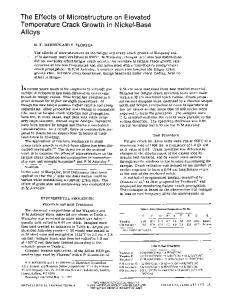Elevated temperature creep-fatigue crack propagation in nickel-base alloys and 1 Cr-Mo-V steel
- PDF / 1,272,134 Bytes
- 8 Pages / 612 x 828 pts Page_size
- 32 Downloads / 421 Views
INTRODUCTION
POWERplants operate in the elevated temperature regime where the possibilities of creep and fatigue deformation are important design considerations. In this context, the aspect of crack propagation is worthy of being addressed. The crack growth may occur by fatigue, creep, and/or environmental effects, and in many instances, mutual interactions among these processes give rise to synergistic effects. Consequently, the development of life prediction criteria requires the capability to predict the subcritical crack growth behavior under different conditions of creep and/or fatigue. The characterization of creep and fatigue crack growth behavior requires the use of an appropriate loading parameter. As candidates for relevant loading parameters for the characterization of CCG, the stress intensity factor KI, the path-independent integral C*, and the net section stress have been proposed in the literature. 1-4 The importance of using the appropriate loading parameter to correlate the CCG data is clearly demonstrated in the work of Koterazawa and Mori. They reported that the crack growth rate varies by two orders of magnitude for different specimen geometries when K I is used as a loading parameter. The aim of this paper is to review the high temperature time dependent and time independent crack growth behavior of four classes of industrially important alloys. These classes are nickel-base ODS alloys, cast nickel-base superalloys, wrought nickel-iron base superalloys, and 1Cr-Mo-V steel. The applicability of the different loading parameters to characterize the time dependent crack growth is discussed in the light of the high temperature deformation behavior as well as the sensitivity of the alloy to oxidizing environments. *IN is a trademark of the INCO family of companies.
M. NAZMY, Group Leader, Metallurgical Lab, W. HOFFELNER, Manager, Materials and Mechanical Engineering, Gas Turbine Division, and C. WOTHRICH, Group Leader, Research Center, are with BBC Brown, Boveri & Co. Limited, CH-5401 Baden, Switzerland. This paper is based on a presentation made in the symposium "Crack Propagation under Creep and Creep-Fatigue" presented at the TMS/AIME fall meeting in Orlando, FL, in October 1986, under the auspices of the ASM Flow and Fracture Committee. METALLURGICALTRANSACTIONS A
II. CRACK GROWTH BEHAVIOR OF ODS ALLOYS
ODS alloys are a new class of powder metallurgy high temperature materials. Their excellent high temperature strength makes them attractive for gas turbine blade and vane applications. The mechanical alloying technique has been used to produce ODS alloys with unique properties that cannot be made by conventional methods. 7 The crack growth behavior of the ODS alloys, MA 754 and MA 6000, will be presented in this investigation. MA 754 is a nickelbase alloy with a composition (in weight percent) of 20.32 pct Cr, 031 pct A1, 0.4 pct Ti, 0.98 pct Fe, 0.05 pct C, 0.57 pct Y203, and balance Ni. MA 6000 is a nickel-base superalloy with a composition (in weight percent) of 15.03 pct Cr, 2.38 pct Ti, 4.
Data Loading...











